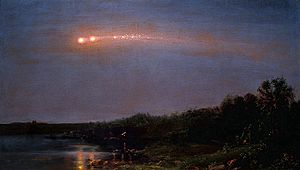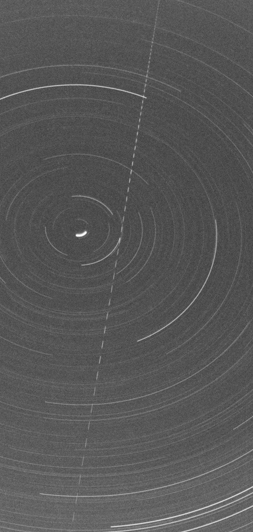Earth-grazing fireball facts for kids

An Earth-grazing fireball is a super bright meteor that comes very close to Earth. Imagine a space rock, called a meteoroid, zooming towards our planet. Instead of crashing, it dips into Earth’s atmosphere and then bounces back out into space! Sometimes, if these space rocks break apart, small pieces can fall to Earth as meteorites. These events are sometimes called Earth-grazing meteor processions or bolides. Two famous examples of these amazing events are the 1972 Great Daylight Fireball and the Meteor Procession of July 20, 1860.
How Earth-Grazers Work
When an Earth-grazer zooms through our atmosphere, it's like skipping a stone on water. The friction from the air slows it down and can even make it lose some of its material. Because of this, its path in space, called its orbit, changes after it leaves Earth's atmosphere. It won't follow the exact same route it was on before its close encounter with our planet.
Earth's atmosphere doesn't have a clear "end" point. Instead, the air just gets thinner and thinner as you go higher. We divide it into layers like the stratosphere, mesosphere, thermosphere, and exosphere. A space rock, or meteoroid, usually starts to glow and becomes a visible meteor when it's about 85 to 120 kilometers (53 to 75 miles) above Earth. This is where the air is just thick enough to create a lot of friction and heat.
Amazing Earth-Grazers We've Observed
Earth-grazing fireballs are quite rare, and scientists don't observe them very often. Here are some of the most famous ones that have been studied:
- July 20, 1860: This event was a spectacular meteor procession. People saw multiple bright objects streaking across the sky.
- February 9, 1913: Another amazing meteor procession happened in 1913. Scientists thought it might have been a temporary natural satellite of Earth that broke apart.
- August 10, 1972 (The Great Daylight Fireball): This was the first Earth-grazer that scientists could study with modern tools. It zoomed over the United States and Canada at about 15 kilometers per second (about 9 miles per second)! It lost about half its original weight and slowed down a lot during its atmospheric journey.
- October 13, 1990: A space rock weighing about 40 kilograms (88 pounds) flew over Czechoslovakia at an altitude of 97.9 kilometers (60.8 miles). This was the first time scientists could figure out its exact path in space using photos from different locations.
- March 29, 2006: A fireball zipped through the atmosphere over Japan at 71.4 kilometers (44.4 miles) high.
- August 7, 2007: This Earth-grazer passed over Europe. Its orbit was similar to a rare type of space rock called an Aten asteroid.
- June 10, 2012: This fireball was part of a meteor shower called the Daytime ζ-Perseid shower. It traveled 510 kilometers (317 miles) across the sky over Spain. It was the dimmest Earth-grazer ever recorded by scientists, and the first one linked to a specific meteor shower.
- December 24, 2014: On Christmas Eve, a slower-moving fireball traveled about 1,200 kilometers (745 miles) over North Africa, Spain, and Portugal.
- July 7, 2017: Scientists using the Desert Fireball Network in Australia watched a fireball travel over 1,300 kilometers (800 miles) through the atmosphere. It came closest to Earth at about 58.5 kilometers (36.4 miles) high. This space rock started in an Apollo-type orbit, but its close encounter with Earth changed its path to one similar to a Jupiter-family comet.
Learn More About Space
- Asteroids that come close to Earth
- Asteroids that cross Earth's path
- What is a Meteoroid?
- The 1913 Great Meteor Procession (Cyrillids)
- Predicting Asteroid Impacts


